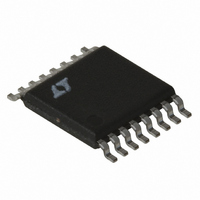LT1976IFE#TR Linear Technology, LT1976IFE#TR Datasheet - Page 13

LT1976IFE#TR
Manufacturer Part Number
LT1976IFE#TR
Description
IC REG SW STEP DWN 1.5A 16-TSSOP
Manufacturer
Linear Technology
Type
Step-Down (Buck)r
Datasheet
1.LT1976IFEPBF.pdf
(28 pages)
Specifications of LT1976IFE#TR
Internal Switch(s)
Yes
Synchronous Rectifier
No
Number Of Outputs
1
Voltage - Output
1.2 ~ 54 V
Current - Output
1.5A
Frequency - Switching
200kHz
Voltage - Input
3.3 ~ 60 V
Operating Temperature
-40°C ~ 125°C
Mounting Type
Surface Mount
Package / Case
16-TSSOP Exposed Pad, 16-eTSSOP, 16-HTSSOP
Lead Free Status / RoHS Status
Contains lead / RoHS non-compliant
Power - Output
-
Available stocks
Company
Part Number
Manufacturer
Quantity
Price
APPLICATIO S I FOR ATIO
capacitive loads or high input voltages can cause a high
input current surge during start-up. The soft-start func-
tion reduces input current surge by regulating switch
current via the V
rate (dV/dt) at the output. A capacitor (C1 in Figure 2) from
the C
dV/dt. When the feedback voltage is below 0.4V, the V
will rise, resulting in an increase in switch current and
output voltage. If the dV/dt of the output causes the current
through the C
reduced resulting in a constant dV/dt at the output. As the
feedback voltage increases I
increased dV/dt until the soft-start function is defeated
with 0.9V present at the FB pin. The soft-start function
does not affect operation during normal load conditions.
However, if a momentary short (brown out condition) is
present at the output which causes the FB voltage to drop
below 0.9V, the soft-start circuitry will become active.
INPUT CAPACITOR
Step-down regulators draw current from the input supply
in pulses. The rise and fall times of these pulses are very
fast. The input capacitor is required to reduce the voltage
ripple this causes at the input of LT1976 and force the
switching current into a tight local loop, thereby minimiz-
ing EMI. The RMS ripple current can be calculated from:
Ceramic capacitors are ideal for input bypassing. At 200kHz
switching frequency input capacitor values in the range of
4.7μF to 20μF are suitable for most applications. If opera-
tion is required close to the minimum input required by the
LT1976 a larger value may be required. This is to prevent
excessive ripple causing dips below the minimum operat-
ing voltage resulting in erratic operation.
Input voltage transients caused by input voltage steps or
by hot plugging the LT1976 to a pre-powered source such
as a wall adapter can exceed maximum V
sudden application of input voltage will cause a large
surge of current in the input leads that will store energy in
I
RIPPLE RMS
SS
pin to the output determines the maximum output
(
SS
)
=
C
capacitor to exceed I
pin to maintain a constant voltage ramp
I
OUT
V
U
IN
V
U
OUT
CSS
(
V
increases, resulting in an
IN
W
–
CSS
V
OUT
the V
)
IN
ratings. The
C
U
voltage is
C
pin
the parasitic inductance of the leads. This energy will
cause the input voltage to swing above the DC level of input
power source and it may exceed the maximum voltage
rating of the input capacitor and LT1976. All input voltage
transient sequences should be observed at the V
the LT1976 to ensure that absolute maximum voltage
ratings are not violated.
The easiest way to suppress input voltage transients is to
add a small aluminum electrolytic capacitor in parallel with
the low ESR input capacitor. The selected capacitor needs
to have the right amount of ESR to critically damp the
resonant circuit formed by the input lead inductance and
the input capacitor. The typical values of ESR will fall in the
range of 0.5Ω to 2Ω and capacitance will fall in the range
of 5μF to 50μF.
If tantalum capacitors are used, values in the 22μF to
470μF range are generally needed to minimize ESR and
meet ripple current and surge ratings. Care should be
taken to ensure the ripple and surge ratings are not
exceeded. The AVX TPS and Kemet T495 series are surge
rated AVX recommends derating capacitor operating volt-
age by 2:1 for high surge applications.
OUTPUT CAPACITOR
The output capacitor is normally chosen by its effective
series resistance (ESR) because this is what determines
output ripple voltage. To get low ESR takes volume, so
physically smaller capacitors have higher ESR. The ESR
range for typical LT1976 applications is 0.05Ω to 0.2Ω. A
typical output capacitor is an AVX type TPS, 100μF at 10V,
with a guaranteed ESR less than 0.1Ω. This is a “D” size
surface mount solid tantalum capacitor. TPS capacitors
are specially constructed and tested for low ESR, so they
give the lowest ESR for a given volume. The value in
microfarads is not particularly critical and values from
22μF to greater than 500μF work well, but you cannot
cheat Mother Nature on ESR. If you find a tiny 22μF solid
tantalum capacitor, it will have high ESR and output ripple
voltage could be unacceptable. Table 3 shows some
typical solid tantalum surface mount capacitors.
LT1976/LT1976B
IN
13
pin of
1976bfg













